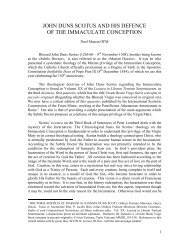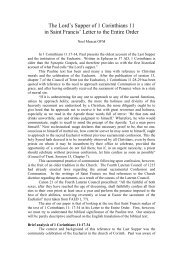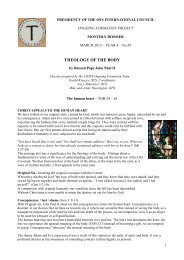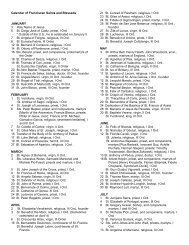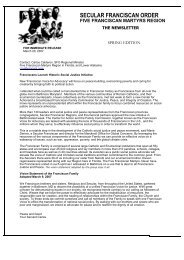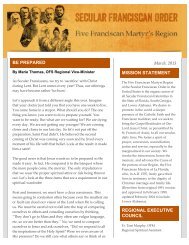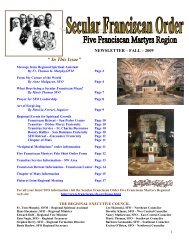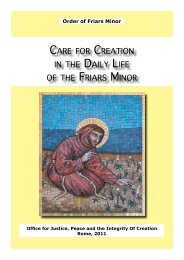June 2010 - Five Franciscan Martyrs Region
June 2010 - Five Franciscan Martyrs Region
June 2010 - Five Franciscan Martyrs Region
You also want an ePaper? Increase the reach of your titles
YUMPU automatically turns print PDFs into web optimized ePapers that Google loves.
Bible Lands<br />
THE COENACULUM,<br />
BIRTHPLACE OF THE HOLY<br />
LAND CUSTODY<br />
The Coenaculum, or Upper Room,<br />
is the sacred place where Jesus<br />
celebrated the Last Supper on Holy<br />
Thursday, where he appeared as the<br />
Risen Lord to the apostles on the<br />
evening of Easter Sunday, and to<br />
Thomas on the following Sunday, and<br />
where the Holy Spirit descended upon<br />
Mary and the Apostles on Pentecost.<br />
For this reason the Coenaculum is<br />
considered to be the mother of all<br />
churches.<br />
The area where the Coenaculum<br />
is found is known as Mount Zion. In<br />
Jerusalem, however, there are two<br />
places that have this name. For the<br />
Jews Mount Zion refers to the temple<br />
mount, whereas for the Christians<br />
Mount Zion is the place where the<br />
Coenaculum is found. The fact that<br />
the Coenaculum has always been considered<br />
as an Upper Room comes from<br />
Luke’s Gospel 22:12. According to the<br />
evangelist Jesus sent Peter and John<br />
to prepare the Last Supper in an<br />
“upper room” (ἀνάγαιον). This detail<br />
has always remained evident in the<br />
indication of the Coenaculum as the<br />
Upper Room.<br />
Bishop Epiphanius of Salamis<br />
(310-403) writes that when emperor<br />
Adrian destroyed Jerusalem in AD 135,<br />
he left standing only a few houses and<br />
the church of the Upper Room where<br />
the disciples gathered after the Lord<br />
ascended into heaven. This hill, on the<br />
western section of Jerusalem, was<br />
spared destruction. In the same area<br />
the Christians also commemorated the<br />
apostle Saint James, first bishop of<br />
Jerusalem, who is venerated in the<br />
Armenian Orthodox cathedral, a short<br />
distance away from the Coenaculum.<br />
The church mentioned by Epiphanius<br />
was restored by Saint Maximus (331-<br />
349). Bishop John II of Jerusalem (386-<br />
417) rebuilt it. During Byzantine times<br />
it used to be known as Hagia Sion (Holy<br />
Zion). In 384 the pilgrim Egeria<br />
describes the liturgy celebrated in the<br />
church of Zion.<br />
Jewish tradition has it that<br />
Zion refers to the city of David. From<br />
415 to 460 Byzantine Christians commemorated<br />
on Mount Zion the tomb of<br />
Saint Stephen, until the remains of the<br />
first martyr were transferred to the<br />
basilica built in his honour by bishop<br />
Juvenal and empress Eudoxia. The<br />
ancient pilgrims state that in the Hagia<br />
Zion Christians also venerated the column<br />
of the Flagellation and the Crown<br />
of thorns.<br />
On Mount Zion the tradition<br />
stating that king David had been buried<br />
at the place was to gain popularity<br />
later on, particularly from the time of<br />
the Crusaders in the 12 th century. In<br />
fact, according to 1Kings 2:10: “David<br />
slept with his ancestors and was buried<br />
in the Citadel of David.” Now the city<br />
of David was not to be found on the<br />
present-day Mount Zion, but rather on<br />
the Ophel hill, south of the temple<br />
mount. Maybe the words of Peter in<br />
4 THE LAND OF THE PROMISE - <strong>June</strong> <strong>2010</strong>



